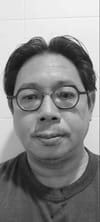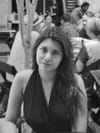MY FIRST VISIT to Pulau Ketam was during the Pulau Ketam International Art Festival in 2016. I was in charge of the printmaking studio located inside a temple, along with a Canadian artist and two artists from the US.
On my first day on the island, I was tasked to decorate the jetty, continuing on until late in the night. It was then that I witnessed a group of dogs chasing and hunting a cat. I was stunned because the cats I knew were usually fiercer than dogs—my cat would often scale walls to fight my neighbour’s dog. As I stood there, the dogs turned their attention to me—and because I could not outrun them, I had to fend them off with my sandals. Eventually, a resident came to help chase them away. He explained that these dogs were wild, unlike dogs on the mainland. It was my first glimpse of the island’s untamed nature.






